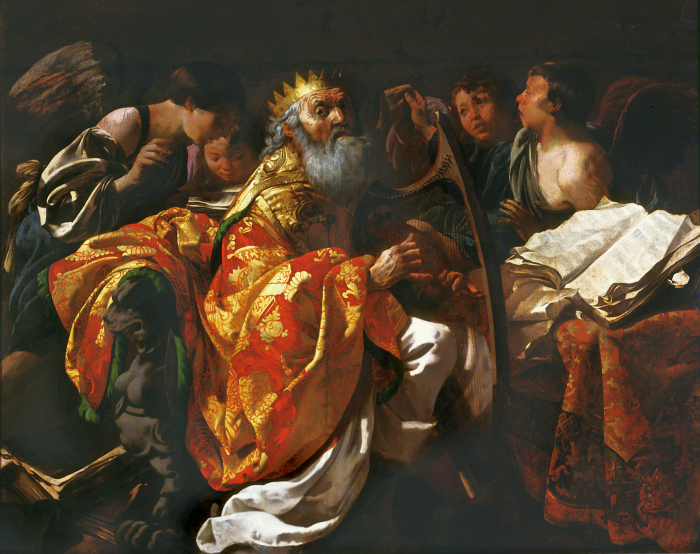
Lesson Objectives
- To understand how Jesus’ parting words to His disciples form a map of the ideal Davidic kingdom.
- To see how the structure of the Acts of the Apostles follows that map.
- To see how Luke paints the nascent Church as the Davidic kingdom perfectly restored.
III. The Good News
A. Peter’s First Sermon
At Pentecost, Peter’s address to the crowd had one central message: the kingdom promised to David had finally arrived, with Jesus Christ as the King.
Peter quoted from David’s own words in Psalm 16, where David says that God will not allow His Holy One to see corruption (see Acts 2:27, quoting from Psalm 16:10).
Now David, Peter argued, is dead and buried, and everyone knows where his tomb is (seeActs 2:29).
Therefore, David could not have been speaking about himself. Instead, as a prophet, he foresaw the coming of Christ, who would rise from the dead and sit on the throne of David (see Acts 2:30-31). Christ sits at the right hand of God, just as David had prophesied (seeActs 2:33-34).
B. The Dispersion Reversed
The result of Peter’s sermon was amazing: three thousand people baptized in a single day (see Acts 2:41).
Even more significant was the variety of people who heard the Good News. Pentecost was an important festival in the Jewish calendar, and Jerusalem had filled up with "devout Jews from every nation under heaven" (see Acts 2:5).
There were "Parthians, Medes, and Elamites, inhabitants of Mesopotamia, Judea and Cappadocia, Pontus and Asia, Phrygia and Pamphylia, Egypt and the districts of Libya near Cyrene, as well as travelers from Rome, both Jews and converts to Judaism, Cretans and Arabs" (see Acts 2:9-11).
This is nothing short of a verbal map of the known world, both inside and outside the Roman Empire. From Rome in the west to Parthia (a giant empire that included large parts of India) in the east, from Pontus in the north to Egypt and Arabia in the south, the people of God had come back together to acknowledge Jesus Christ as their King.
All the nations had Jewish populations because, after Israel and Judah were conquered, the Jews had been dispersed throughout the world.
Now "devout Jews" from everywhere in the Dispersion had heard and accepted the message Peter brought them: the message that the Kingdom was restored, and that the perfect King prophesied long ago was now reigning.
In this scene, Luke paints a picture of Israel reunited under Christ as king. It is the news that the Son of David, the Lord’s Anointed, the perfect Davidic King, has begun his reign that persuades three thousand people to accept Christian baptism.
C. Preaching the Kingdom Restored/h5>
The Kingdom is restored! This is the message the first Christians preach again and again throughout the book. It is always the Apostles’ most effective message. The news that the Kingdom had been restored is what brings thousands of souls into the Kingdom.
Peter’s first sermon sets the tone. After the Church is scattered from Jerusalem (see Acts 8:1), Philip preaches the Kingdom in Samaria (see Acts 8:12).
Paul’s sermon in Antioch of Pisidia (see Acts 13:14-42) has the same theme as Peter’s first sermon, and even quotes some of the same texts from Scripture.
Paul gives a brief summary of salvation history, from the Exodus to David (see Acts 13:17-22), and then announces that Jesus Christ was the promised Son of David who came to save Israel (see Acts 13:23).
He backs up his declaration with quotations from the Psalms (see Acts 13:33; Psalm 2:7;Acts 13:35; Psalm 16:10) and the prophets (see Acts 13:34; Isaiah 55:3; Acts 13:41;Habakkuk 1:5).
Paul even makes the same argument that Peter did: that David died and was buried, so the promises could not have been for him (see Acts 13:36); instead, it was Jesus Christ in whom the promises were fulfilled (see Acts 13:37).
Once again, the message is received with enthusiasm, and many of the people who heard it are persuaded (see Acts 13:42-43) - especially among the Gentile "god-fearers" who believe in the True God but have not been circumcised.
Paul preaches the same news about the Kingdom all through Asia (see Acts 19:8-10, Acts 20:25).
When the newly converted Christians are suffering trials, it does not cause them to doubt the news of the Kingdom. Instead, the news of the Kingdom is what comforts and strengthens them (see Acts 14:22).
Not only are the dispersed Israelites being reunited under their true King, but His dominion is also being extended to all the nations of the earth, as God had promised the Son of David (see Psalm 89:28).
D. The Ends of the Earth
As a narrative, the Acts of the Apostles seems to end abruptly. Indeed, it may well have stopped at what for Luke was the present time.
Paul is in prison - really more of a house arrest (see Acts 28:16) in Rome. He had appealed to the Emperor (see Acts 25:10-12), which was the right of a Roman citizen, a privilege into which Paul was born (see Acts 22:25-29).
We do not know what happens to Paul after that - which seems a very strange lack of resolution by modern narrative standards.
But when we look at the structure of the book, we see that Luke has perfectly completed his program.
Jesus had told His followers that they would be His witnesses "in Jerusalem, throughout Judea and Samaria, and to the ends of the earth" (see Acts 1:8).
Now, having stopped at all the points between, here we are at the ends of the earth: Rome, the capital of the world.
Here Paul spends his time teaching anyone who will listen about the Kingdom (see Acts 28:23)
In fact, our very last glimpse of Paul, and Luke’s very last words to us, show him still proclaiming the Kingdom. The Acts of the Apostles ends with the news about the Kingdom still ringing in our ears.
The reason we don’t know what happens to Paul is this: it makes no difference. That is not the point of the book. The point is that the mission is accomplished. Paul has reached Rome, preaching the Gospel to the ends of the earth.
The Kingdom is restored, and whatever happens to Paul will not change that. Christ the King reigns, Most High over all the kings of the earth. He rules a Kingdom not built on conquest but on persuasion; not held together by force but by love. It is a kingdom infinitely more glorious than Solomon’s (compare Matthew 12:42), and it will last forever.
Lesson Outline
Other Lessons
- Lesson One: A Throne Established Forever
- To begin to appreciate the significance of God’s covenant with David for understanding the content and meaning of the New Testament.
- To understand the biblical idea of the monarchy and the Old Testament background for the Davidic covenant.
- To understand the basic outlines of the promises made to David and the shape of the Davidic kingdom under both David and Solomon.
- Lesson Two: Looking for the ‘New David’
- To understand the basic outline of Israel’s history in the centuries between the collapse of the Davidic kingdom and the beginning of the New Testament era.
- To appreciate how the collapse and disappearance of the Davidic Kingdom shaped Israel’s hopes and beliefs in the five centuries before Christ.
- To understand how God’s covenant promises were interpreted by Israel’s prophets and how those prophecies were understood in the last centuries before Christ.
- Lesson Three: The Son of David in Matthew’s Gospel
- To understand the symbolism Matthew uses to convey the truth that Jesus Christ is the perfect Son of David.
- To see how the baptism of Jesus corresponds to the anointing of the Davidic kings.
- To understand how Matthew sees Jesus’ kingdom as the fulfillment of the promises in the prophets.
- Lesson Four: The Throne of David, His Father
- To see how Luke emphasizes Jesus’ lineage as Son of David in the infancy narrative.
- To see how Jesus appears in public as the Son of David throughout Luke’s Gospel.
- To understand how, at the climax of Luke’s Gospel, Jesus takes his place as heir to the kingdom of David.
- Lesson Six: ‘The Key of David’: Church and Kingdom in the New Testament
- To understand the characteristics and identity of the kingdom of God as it is portrayed in the New Testament epistles and the Book of Revelation.
- To see how the Church is identified with the kingdom in the New Testament.
- To understand how the Church, as it is portrayed in the New Testament, bears the characteristics of the Davidic kingdom.

